By Maureen Foster
Sandy Hook and the neighboring Highlands of the Navesink have always played an important role in the safety and defense of New York harbor.
During the Revolutionary War (1776-1783), British troops and Loyalist refugees occupied Sandy Hook, while the Patriots controlled the surrounding New Jersey shoreline. Both sides took advantage of the strategic location of the Hook. Sandy Hook Bay provided a safe harbor for British ships bringing supplies to their troops. Patriotic observers on the shore monitored and reported the movements of ships in the bay. Privateers of both sides frequented the bay, at times taking advantage of the Shrewsbury Inlet, which permitted ships access to the bay from the ocean rather than having to sail all the way around the tip of Sandy Hook. In 1778, the Shrewsbury Inlet had been once again opened by the sea during a storm, and it remained open for another 20 years.
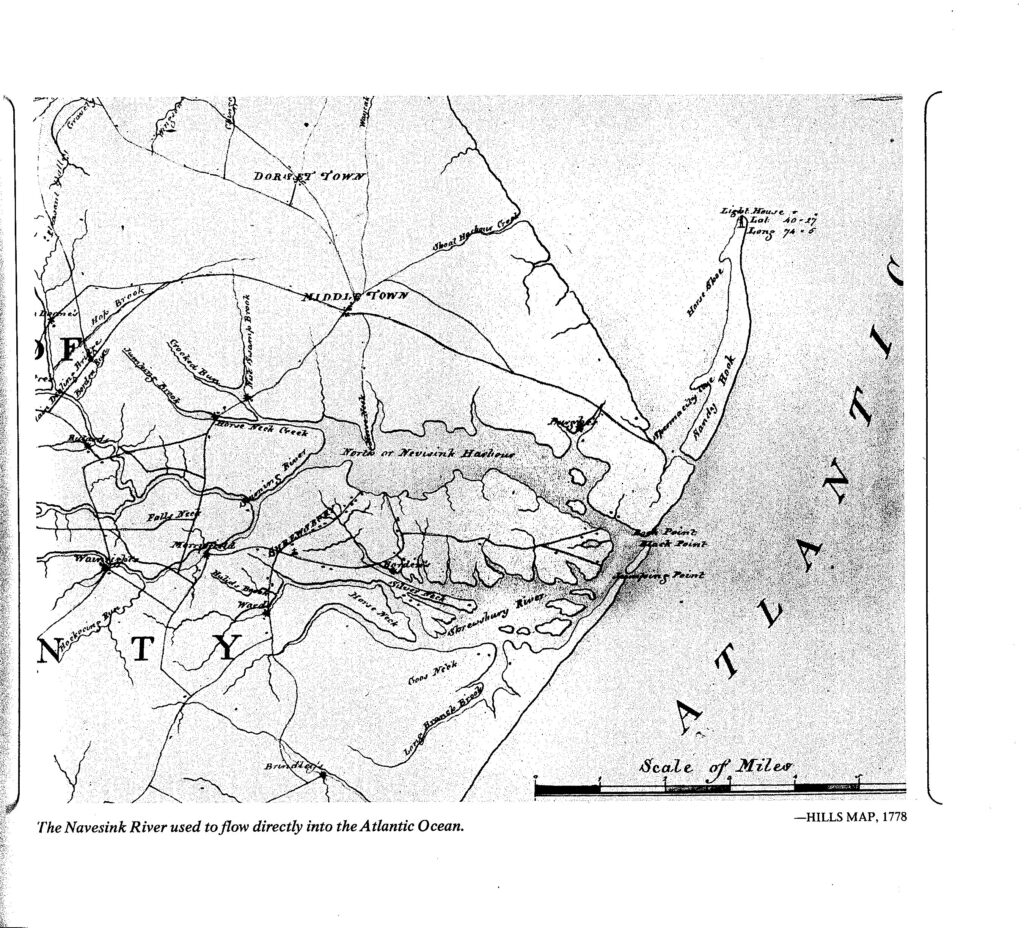
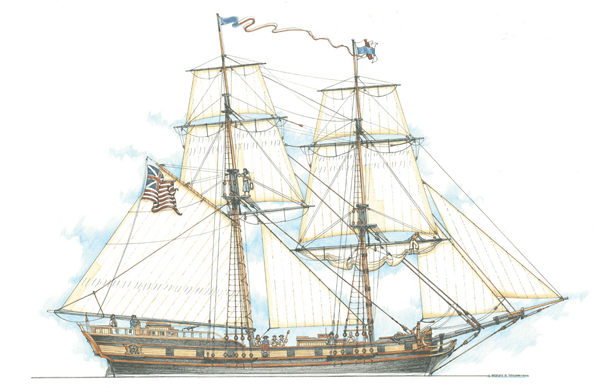
The brigantine Britannia was under the command of a British privateer, Jonathan Stout. A typical brigantine of this era was a sailing vessel square-rigged on the foremast, and a gaff-rigged mainsail with square rig above it on the mainmast. The Britannia was outfitted with 20 guns, both 6- and 12- pounders. A privateer was a private citizen with a license from a government to wage naval war against vessels of a specific enemy nation, a way of extending a formal Navy with volunteers incentivized by the promise of a share of whatever they captured. During the Revolution, both the British and Continentals used privateers, the British against France and Spain, and the Patriots against the British.
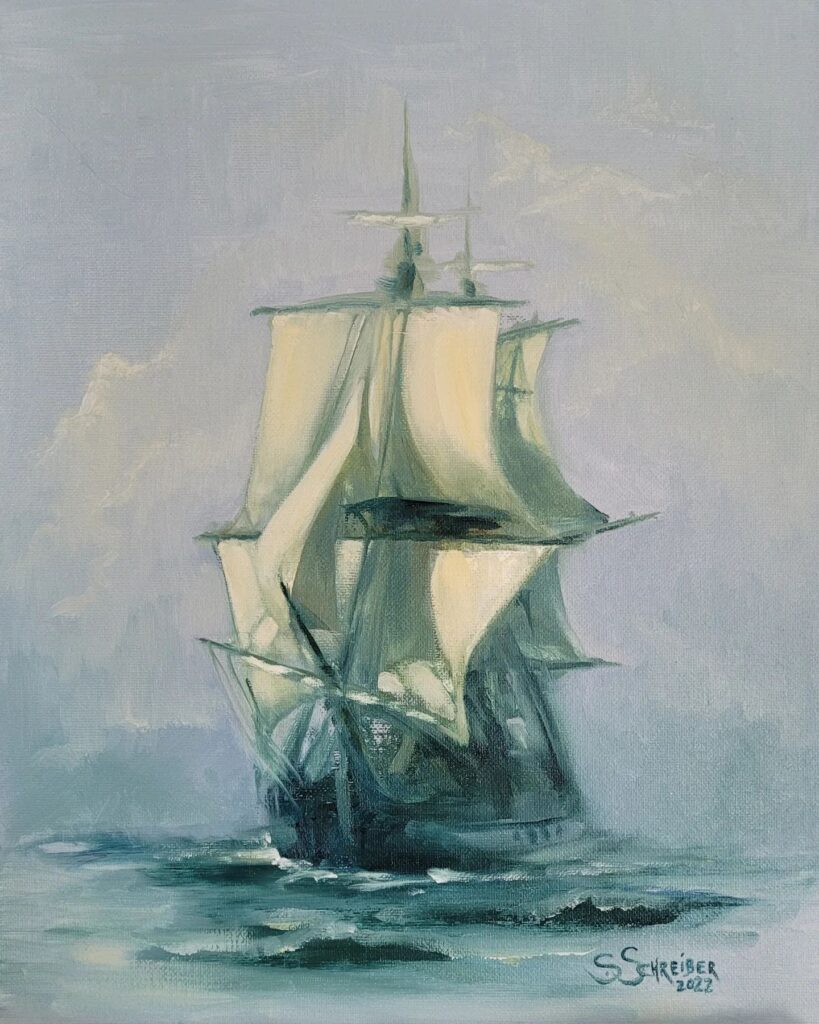
On the night of December 28, 1779, in the midst of a Nor’easter, the Britannia broke loose from her mooring in Sandy Hook Bay. The storm’s strong winds drove the ship toward the western shore of the harbor. Contemporary accounts mention fields of ice in the harbor preventing any assistance reaching the vessel, and an exhausted crew that was not able to save their ship.
A British ship dragging its anchors toward the western shore of the bay was a welcome sight to members of the 1st Regiment of the Monmouth Militia stationed on the high ground of the Highlands of the Navesink. First, any interruption of British shipping hampered the enemy’s ability to supply the troops occupying New York City. Second, if the Militia men could capture the brigantine, they could claim its cargo, fittings, and rigging, and put the hull up for sale. The money realized by the sale would be a windfall to the Militia men and their families.
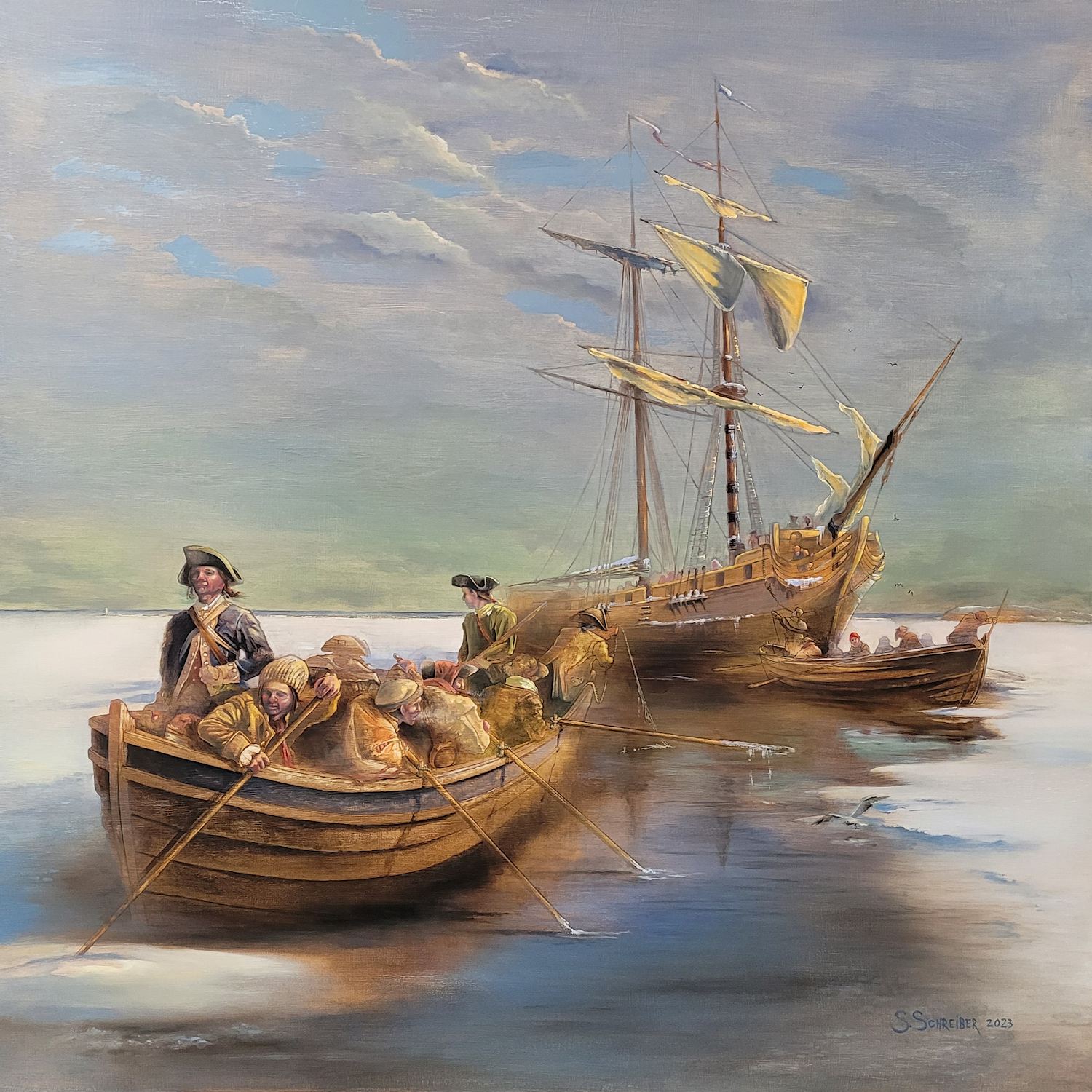
The Monmouth Militia were under the command of Colonel Asher Holmes. Holmes was raised at his family’s plantation, Scotschester, in what is today Colts Neck, and in 1776 was commissioned Major, 1st Regiment, Monmouth Militia. He was promoted to the rank of Colonel in 1778. He served during the battles of Trenton (1776), Germantown (1777), and Monmouth (1778), and in addition to the Britannia, was instrumental in the capture of the Polacre (1792), and of the Funetur (1783). His own residence, still standing, but only barely, is in Marlboro Township, badly in need of repairs. Editor’s note: Sadly, the Asher Holmes house failed to receive support in time, and collapsed during a heavy snowstorm.
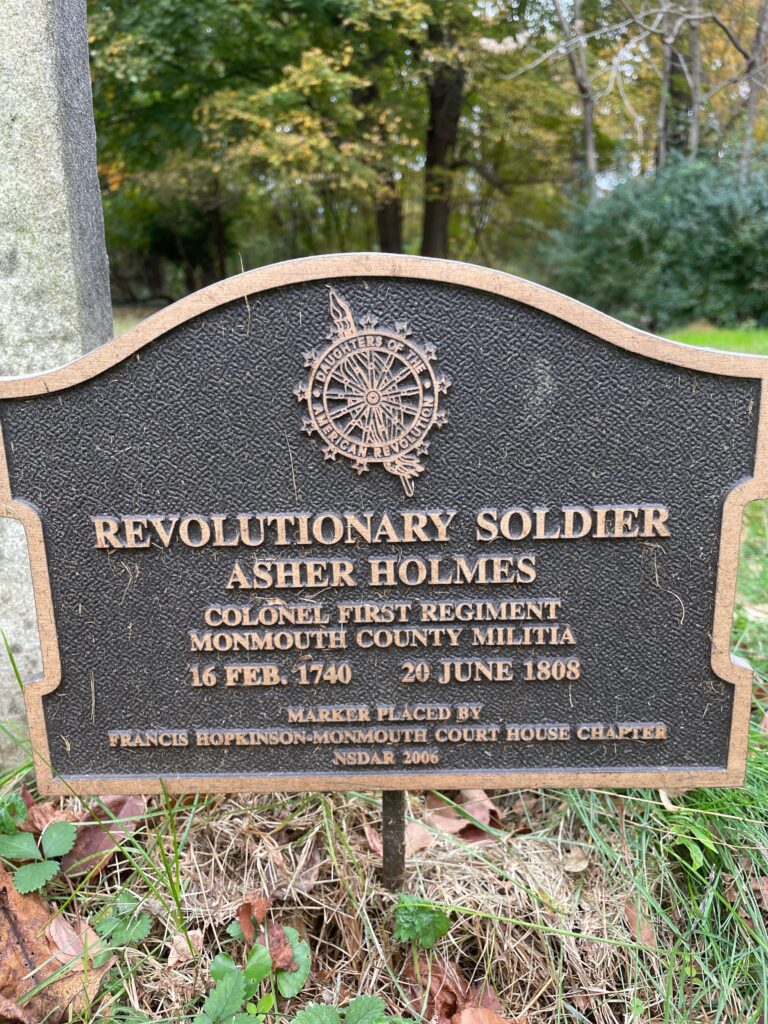
By the early hours of December 29, the news of the ship’s condition spread to Holmes and his men, who had assembled along the shore to assess the situation. By the next day, they gained control of the Britannia somewhere near Shoal Harbor (current day Port Monmouth).
To remove the cargo and strip the ship for resale, it had to be towed by militia oarboats from the bay to one of the many creeks flowing into the bay, and the order was given to move the Britannia to the quiet waters of Cheesequake Creek, in Middlesex County.
Once the ship was relocated, the militia men worked in shifts to unload it and to guard it at night. The Monmouth County Historical Association (MCHA), Freehold, has original pay slips, dated January 1780, for many of the men who stripped and guarded the ships. For their efforts, these men received £1 for each day they worked. This payment in addition to the anticipated distribution of the sale proceeds.
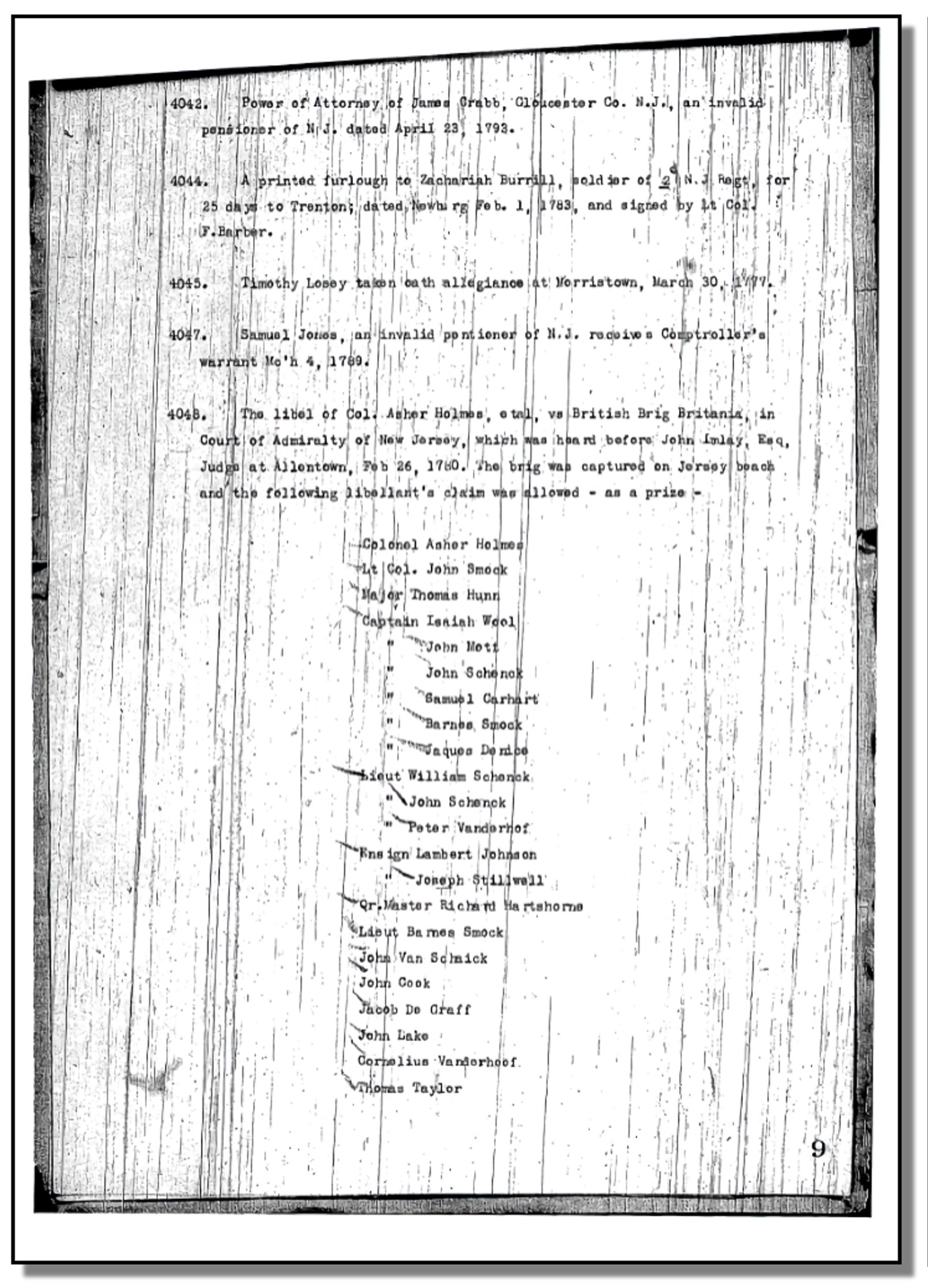
But before the Militia men could receive their share of the proceeds, the New Jersey Court of Admiralty was required to determine if they had the right to sell the captured cargo and ship’s parts. The February 2, 1780 edition of the New Jersey Gazette published a notice that the Admiralty Court would hear the case on February 24, 1780. On February 26, 1780, the Court of Admiralty ruled in favor of Col. Holmes and his men.
Over the next few weeks, sales of various lots of the Britannia’s cargo and infrastructure were advertised for sale in the New Jersey Gazette. These sales took place at the homes of county residents. For example, on January 13, 1780, the Gazette published notice of the upcoming sale of Britannia’s cargo and supplies at the home of Garret Schank of Middletown. Along with beef, pork, coffee, sugar, powder, lead, muskets, and swords, the hull of the Britannia was offered for sale.
On March 5, 1780, the Commander and officers of the 1st Regiment agreed to distribute the proceeds of the sales according to the rank of each participant. Col. Holmes was to receive 11 ¼ shares of the proceeds. His officers received between 3-9 shares. The enlisted men received 2/3 of one share.
MCHA records show that the sales netted at least £29,718, or about £297 per share. For Col. Holmes, this meant a payment of £3,341 (£297 x 11.25). Enlisted men each received about £198 (£297 x .66). To put these payments into perspective, the daily pay for unloading and guarding the ship was £1.
The men of the Monmouth Militia were mostly farmers or fishermen. Their share of the prize money would have been a welcomed addition to their family finances. But, in spite of the opportunity for financial gain, we cannot ignore the fact that during a frigid December Nor’easter, these men risked their health and safety to perform patriotic service by taking part in the capture of the British brigantine Britannia.
The following is a list of men who were involved with the capture of the Britannia in one capacity or another:
| Asher Holmes |
| John Smock |
| Thomas Hunn |
| Isaiah Wool |
| John Mott |
| John Schanck |
| Samuel Carhart |
| Barnes Smock |
| Jaques Denice |
| William Schenck |
| John Schanck |
| Peter Vanderhoff |
| Lambert Johnson |
| Joseph Stillwell |
| Richard Hartshorn |
| Barnes Smock |
| John Van Schaick |
| John Cook |
| Jacob DeGroff |
| John Lake |
| Cornelius Vanderhoof |
| Thomas Taylor |
| Joseph Tilton |
| Henry Striker |
| John Bennet |
| Robert Lard |
| Garret Stillwell |
| John Covenhoven |
| William Ogben |
| William Covenhoven |
| Samuel Pearce |
| James Wall |
| Joseph Holmes |
| Garret Schanck |
| Cornelius Tunison |
| Joseph Johnson |
| Thomas Stout |
| John Hoff |
| Joseph Willet |
| Hendrick Vanderbilt |
| John Stillwell |
| Joseph Dorsett |
| John Dorsett |
| William Dean |
| Benjamin Wilson |
| Samuel Truax |
| Matthias Covenhoven |
| William Thompson |
| Adam Stryker |
| Humphrey Willet |
| James Seabrook |
| James Wilson Cooper |
| Tunis Anderson |
| Garret Garrison |
| Edward Moore |
| Thomas Biddle |
| Joseph Walling |
| Peter Tanner |
| Richard Poole |
| William Pew |
| Jacob Sheppard |
| Cornelius Smock |
| William Sanford |
| Thomas Carhart |
| John Walling |
| Daniel Walling |
| William Aumack |
| Joel Biddle |
| James Walling |
| Thomas Walling |
| William Walling |
| Chrineyonce Schenck |
| William Bowne |
| Elias Bowne |
| James Roberts |
| John Walling (son of Gershom) |
| John Carhart |
| Joseph Roberts |
| Matthias Tyson |
| Samuel Poling |
| Richard Poling |
| John Collins |
| George Poole |
| Thomas Roberts |
| William Roler |
| Philip Walling |
| Jonathan Bailey |
| Jacob Allen |
| Burrows Morris |
| Samuel Smith |
| Cornelius Covenhoven (son of Ruliff) |
| Cornelius Covenhoven (son of Albert) |
| Thomas Convay |
| Matthew Roberts |
| Philip Freneau |
| Thomas Geron |
| Carhart Walling |
| CorneliusP Vanderhoof |
| Cornelius Dorn |
| John Walling (son of Cors.) |
| Manasah Dunham |
| Johannes Van Pelt |
| Dennis Forman |
| Jonathan Pearce |
| James Whitlock |
| Alexander Van Pelt |
| Walter Van Pelt |
| James Marsh |
| Tunis Van Pelt |
| William Van Pelt |
| Hendrick Van Pelt |
| Hendrick Hendrickson |
| Garret Covenhoven |
| Christopher Van Pelt |
| Jacob Van Pelt |
| Matthias Hulsart |
| William Hulsart |
| Stephen Van Brackle |
| Timothy Hight |
| Hendrick Hyers |
| Adrian Carle |
| Derrick Sutphen |
| Tunis Vanderveer |
| Tunis Aumack |
| Tunis Voorhees |
| Benjamin Van Mater |
| James Hogeland |
| Nicholas Worrel |
| Joseph Vanderveer |
| John Reid |
| Samuel Hensey |
| John Aumack |
| Isaac Statesir |
| James Sickles |
| Jonathan Reed |
| William Covert |
| Ezekial Lewis |
| Abraham Hendrickson |
| John Hendrickson |
| Kort Van Schoick |
| James McDuffe |
| Ebenezer Hart |
| Daniel Philmele |
| Joseph Smith |
| Elias Hendrickson |
| John Burrows |
| Hendrick Hendrickson |
| Daniel Hendrickson Jr |
| Samuel Ogbern |
| Abraham Lane |
| William Covenhoven Jr |
| Cornelius Covenhoven Jr |
| Jonathan Forman |
| Mattias Tyson |
| William Blane |
| Jacobus Hubbard |
| John Wilson |
| William Anderson |
| Jacob Bennet |
| John Davis |
| James Dorsett |
| James Taylor |
| George Taylor |
| Cornelius Covenhoven |
| Jonathan Bird |
| Andrew Brown |
| Samuel Dennis |
| Samuel Dorsett |
| Timothy Hulse |
| Enoch Morgan |
| Jacob Tice |
| Benjamin Tilton |
| John Tyson |
About the Author:
Maureen Foster is a member of the Middletown Chapter of the National Society of Daughters of the American Revolution, a vibrant group of women with a passion for serving the community, especially our veterans, and preserving history. Although she currently lives in Oceanport, she has deep roots in Middletown and its history. Her 5th Great Grandfather, Private Alexander Clark of the 1st Regiment of the Monmouth Militia, was killed at the Battle of Navesink, February 13, 1777. Her ancestor Richard Poling, also a 5th Great Grandfather, took part in the capture of the Britannia.
Sources:
Collection 22, Cherry Hall Papers, 1682-1941, Asher Holmes (1740-1808), Box 6, Folder 8, Brig Brittania, Accts. & Receipts, 1775-1785; n.d., Monmouth County Historical Association, Freehold, N.J.
New Jersey Gazette, Trenton, New Jersey, Volume III, Issue 110, p. 4; geneologybank.com
The New York Gazette: and the Weekly Mercury, No. 1472, January 3, 1780; New Jersey, U.S. Published Archives Series, 1631-1782, Volume IV, Newspaper Extracts, 1779-1780, p. 121; ancestry.com.
Shomette, Donald Grady. (2016). Privateers of the Revolution: War on the New Jersey Coast, 1775-1783. Schiffer Military. Atglen, Pa.
Image: “A Naval Brigantine in a Calm Sea” by John Clevely, 1752, © National Maritime Museum, Greenwich, London. Available: https://www.rmg.co.uk/collections/objects/rmgc-object-12535.
Image: Highlands Reach, January 3, 2018, by Rusty Swivel, StripersOnline.com. Available: https://www.stripersonline.com/surftalk/topic/715320-icy-sandy-hook-bay/
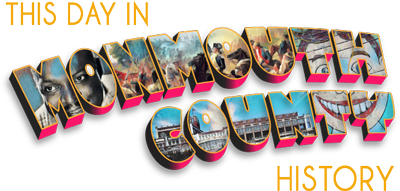
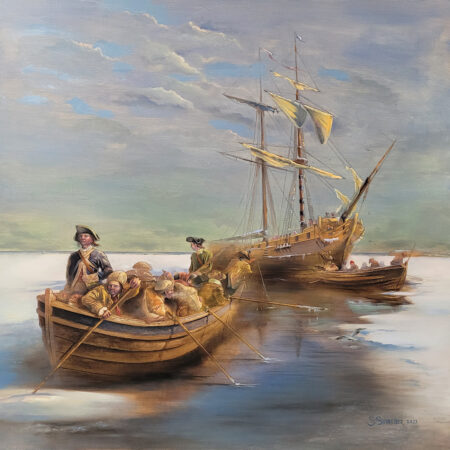
I have never been a student who had the patience for many forms of history unless it was of my interest . The “
Tall Ship Study by Steve Schreiber, along with many of his paintings has truly inspired me and left me with the desire to learn more.. I enjoyed reading this story very much . Sincerely Diana Capra
Great writing, great detail, great storytelling.
My 4th Great Uncle Ebenezer Hart’s Revolutionary War pension papers state that he was part of the militia group that captured the Britannia, although I don’t see his name on this list. He was the son of Levy hart and Catherine Applegate of “Hart’s Tavern”/Colts Neck. Catherine married Joshua Huddy after Levy Hart died in 1775.
Thanks for your comment. The author, Maureen Foster, is going to update her story to include a list of other names of men involved in this story, I would expect that, given the documentation you cite, that Ebenezer Hart will be among them, I’ll let her know either way just to make sure. We expect this to happen early next month. – John Barrows
A fine account of the event by James S. Brown can be accessed in the Asbury Park Press of October 1, 1967, p.15 titled “Ill Wind Blew in a Storm.” Asher Holmes is also an effective search term for it.